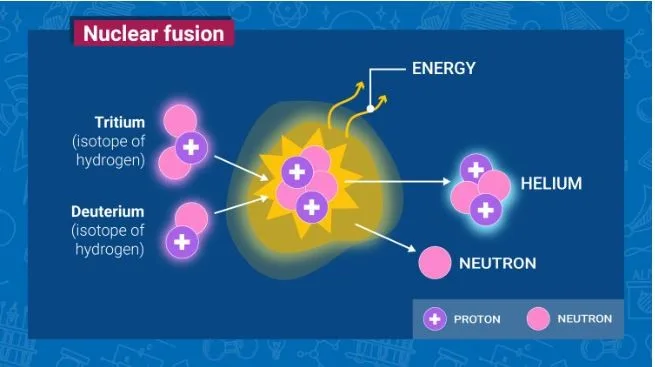Syllabus: GS3/Science and Technology
Context
- Chinese scientists reported that they were able to maintain a plasma at a temperature of 100 million degrees C for about 1,066 seconds in a nuclear fusion reactor called the Experimental Advanced Superconducting Tokamak (EAST).
About
- EAST is a testbed reactor for (International Thermonuclear Experimental Reactor) ITER, an international megaproject.
- Members of the Project: Six countries around the world, including India, and the European Union.
- They are working together to build a tokamak that will sustain nuclear fusion that releases more energy than that required to sustain the plasma.
- A tokamak is a machine that uses magnetic fields to confine plasma for nuclear fusion research.
Background
- 1939: Lise Meitner and Otto Frisch explained fission as a process of energy release.
- 1942: The first sustainable nuclear fission reactor was built by Enrico Fermi and team.
- Nuclear fission produces harmful radioactive waste whereas nuclear fusion doesn’t.
- Nuclear fusion reactors have become an important technological goal for a world keenly interested in new sources of clean energy.
- Current Progress: Projects like ITER are working on creating viable fusion reactors, but net-positive energy from fusion is still a work in progress.
What is Nuclear Fusion?
- Nuclear fusion is the process by which two light atomic nuclei combine to form a single heavier one while releasing massive amounts of energy.
- Fusion reactions take place in a state of matter called plasma — a hot, charged gas made of positive ions and free-moving electrons with unique properties distinct from solids, liquids or gases.
- The sun, along with all other stars, is powered by this reaction.
- Process: The Deuterium (H-2) and Tritium (H-3) atoms are combined to form Helium (He-4). A free and fast neutron is also released as a result.
- The neutron is powered by the kinetic energy converted from the ‘extra’ mass left over after the combination of lighter nuclei of deuterium and tritium occurs.
- Challenges: Achieving controlled fusion requires extremely high temperatures and pressures, similar to those in stars.

Significance of Fusion energy?
- Clean Energy: Nuclear fusion does not emit carbon dioxide or other greenhouse gases into the atmosphere, so it could be a long-term source of low-carbon electricity from the second half of this century onwards.
- More Efficient: Fusion could generate four times more energy per kilogram of fuel than fission (used in nuclear power plants) and nearly four million times more energy than burning oil or coal.
- Fusion fuel is plentiful and easily accessible: Deuterium can be extracted inexpensively from seawater, and tritium can potentially be produced from the reaction of fusion-generated neutrons with naturally abundant lithium.
- These fuel supplies would last for millions of years.
- Safer to Use: Future fusion reactors are also intrinsically safe and are not expected to produce high activity or long-lived nuclear waste.
- Furthermore, as the fusion process is difficult to start and maintain, there is no risk of a runaway reaction and meltdown.
Way Ahead:
- EAST’s successes are crucial for ITER’s future, which faces criticism for delays and cost overruns.
- ITER’s cost exceeds EUR 18 billion, making it the most expensive science experiment in history.
- High costs have deterred some governments from pursuing such projects.
- Alternative Fusion Methods:
- Stellarator: A device with a twisting design that eliminates the need for a poloidal magnetic field, using complex external magnets to achieve magnetic confinement.
- Laser Fusion: Uses powerful laser beams to compress deuterium-tritium pellets, causing fusion and releasing energy.
- The heat from laser fusion can be used to generate steam, which drives turbines to produce electricity.
Source: TH
Previous article
RuTAGe Smart Village Center (RSVC)
Next article
News In Short-18-02-2025